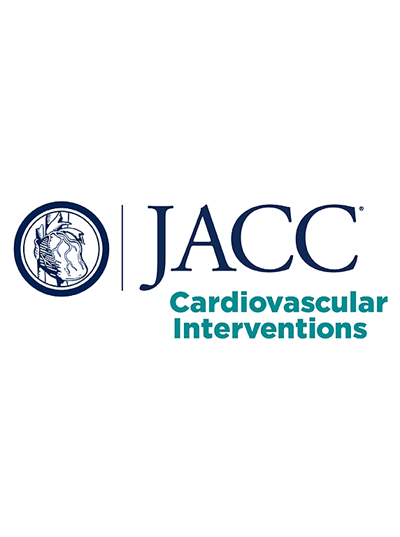经导管主动脉瓣置换术中,电手术小叶修改预防冠状动脉阻塞
IF 11.4
1区 医学
Q1 CARDIAC & CARDIOVASCULAR SYSTEMS
引用次数: 0
摘要
背景:在解剖结构高危的患者中,经导管主动脉瓣置换术(TAVR)有冠状动脉阻塞的风险,这与高发病率和死亡率相关。生物假体或天然主动脉扇贝故意撕裂术预防医源性冠状动脉阻塞(BASILICA)是预防冠状动脉阻塞的有效方法。目的:作者试图测试TELLTALE(经壁电外科小叶穿越和撕裂设备)的安全性和有效性,这是第一个专用的经导管电外科小叶修改系统。方法TELLTALE试验(NCT05666713)招募了因先天性主动脉狭窄或生物假体瓣膜衰竭而接受TAVR的高风险或禁忌性手术的患者,其中计算机断层扫描核心实验室证实有冠状动脉阻塞的高风险。主要疗效终点是导管实验室的技术成功,主要安全性终点是住院安全。结果共纳入美国11个中心的90例受试者(年龄79[75-82]岁,66%[59/90]为女性,30例主动脉狭窄,60例生物瓣膜衰竭)。计算机断层扫描证实冠状动脉梗阻高危(冠状动脉高度8.2 [6.3-10.8]mm,瓣膜至冠状动脉距离3.4 [2.7-3.7]mm,瓣膜至窦小管连接处距离1.2 [0.7-1.7]mm)。小叶修改是简单和可靠的,平均每位参与者1次穿越和撕裂尝试。100% (95% CI: 95%-100%)的参与者达到了主要疗效终点。96% (95% CI: 88%-99%)的参与者达到了主要的安全终点,包括零死亡率,3例中风(1例致残,2例非致残)和1例经导管心脏瓣膜联合缝合后排列不当引起的冠状动脉阻塞。30天,无死亡,无迟发性冠状动脉阻塞。结论采用TELLTALE系统对先天性主动脉瓣狭窄或生物瓣膜衰竭的高危冠状动脉梗阻患者行TAVR手术是安全有效的。本文章由计算机程序翻译,如有差异,请以英文原文为准。
Electrosurgical Leaflet Modification to Prevent Coronary Obstruction During Transcatheter Aortic Valve Replacement in Failing Native and Bioprosthetic Valves
Background
In patients with high-risk anatomy, transcatheter aortic valve replacement (TAVR) risks coronary obstruction which is associated with high morbidity and mortality. Bioprosthetic or native aortic scallop intentional laceration to prevent iatrogenic coronary artery obstruction (BASILICA) is effective at preventing coronary obstruction.
Objectives
The authors sought to test the safety and effectiveness of TELLTALE (Transmural Electrosurgery LeafLet Traversal And Laceration Equipment), the first dedicated transcatheter electrosurgery leaflet modification system.
Methods
The TELLTALE trial (NCT05666713) enrolled participants with high or prohibitive surgical risk undergoing TAVR for native aortic stenosis or bioprosthetic valve failure and in whom computed tomography core laboratory confirmed high risk of coronary obstruction. The primary efficacy endpoint was technical success in the catheterization lab and the primary safety endpoint was inpatient safety.
Results
A total of ninety participants (age 79 [75-82] years, 66% [59/90] female, 30 native aortic stenosis, 60 bioprosthetic valve failure) were enrolled at 11 centers in the United States. High risk of coronary obstruction was confirmed by computed tomography (coronary height 8.2 [6.3-10.8] mm, valve-to-coronary distance 3.4 [2.7-3.7] mm, valve-to-sinotubular-junction distance 1.2 [0.7-1.7] mm). Leaflet modification was easy and reliable with median 1 traversal and laceration attempt per participant. The primary efficacy endpoint was met in 100% (95% CI: 95%-100%) of participants. The primary safety endpoint was met in 96% (95% CI: 88%-99%) of participants, including zero mortality, 3 strokes (1 disabling, 2 nondisabling), and 1 coronary obstruction from transcatheter heart valve commissural suture pos-malalignment. At 30 days, there was zero mortality and zero delayed coronary obstruction.
Conclusions
Electrosurgical leaflet modification using the TELLTALE system is safe and effective in patients undergoing TAVR for native aortic stenosis or bioprosthetic valve failure at high risk of coronary obstruction.
求助全文
通过发布文献求助,成功后即可免费获取论文全文。
去求助
来源期刊

JACC. Cardiovascular interventions
CARDIAC & CARDIOVASCULAR SYSTEMS-
CiteScore
11.60
自引率
8.80%
发文量
756
审稿时长
4-8 weeks
期刊介绍:
JACC: Cardiovascular Interventions is a specialist journal launched by the Journal of the American College of Cardiology (JACC). It covers the entire field of interventional cardiovascular medicine, including cardiac, peripheral, and cerebrovascular interventions. The journal publishes studies that will impact the practice of interventional cardiovascular medicine, including clinical trials, experimental studies, and in-depth discussions by respected experts. To enhance visual understanding, the journal is published both in print and electronically, utilizing the latest technologies.
 求助内容:
求助内容: 应助结果提醒方式:
应助结果提醒方式:


